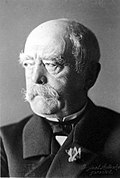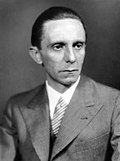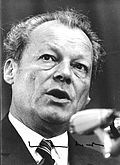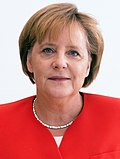List of chancellors of Germany
Wikimedia list article From Wikipedia, the free encyclopedia
Remove ads
The chancellor of Germany is the political leader of Germany. They choose all other members of the government and lead cabinet meetings.[1]
- Top left: Bismarck became the first chancellor with the creation of the North German Federation (1867) and later the German Empire (1871).
- Top right: Adolf Hitler was chancellor (from 1933) and later Führer (dictator) of Nazi Germany.
- Bottom left: In 1949, Konrad Adenauer became the first chancellor of West Germany after World War II.
- Bottom right: Helmut Kohl was chancellor during the period of German reunification.
The office first started in the North German Confederation in 1867.[2] Otto von Bismarck became the first chancellor. The unification of Germany and start of the German Empire in 1871 meant that the Confederation changed into a German country. Its leader was called chancellor of Germany.[3]
At first, the chancellor was only an advisor to the emperor. The emperor chose the chancellor. Later this changed. Under the 1919 Weimar Constitution, the elected President chose the chancellor.[4] In Nazi Germany, politicians ignored the constitution. The chancellor became a dictator under Adolf Hitler. During Allied occupation, there was no chancellor in East or West Germany. This changed after the 1949 Basic Law. This made the chancellor the most important job in the government. The president became less important.[5]
Remove ads
North German Confederation, Bundeskanzler (1867–1871)
The North German Confederation started after the German Confederation ended. This happened because Prussia won the Austro-Prussian War of 1866. The Prussian king chose the Chancellor.[2]
Political party
Remove ads
German Empire, Reichskanzler (1871–1918)
The German Empire started from the North German Federation because of the Franco-Prussian War. The new Emperor named the chancellor to advise him.[3]
Political parties
Zentrum None
Remove ads
Revolutionary period, Reichskanzler (1918–1919)
On 9 November 1918, chancellor Max von Baden gave his office to Friedrich Ebert. Ebert continued to be the head of government during the three months between the end of the German Empire in November 1918 and the start of the National Assembly in February 1919. He was Chairman of the Council of the People's Deputies together with USPD Leader Hugo Haase.[6]
Political party
Weimar Republic, Reichskanzler (1919–1933)
The Weimar Constitution of 1919 started the Weimar Republic. The chancellors often needed support from the President.[5][4]
Political parties
- The title of chancellor was not formally used until the Weimar Constitution took effect. Instead Scheidemann and Bauer were appointed as Reichsministerpräsident (Minister-President or Prime Minister).
- Müller was the last parliamentary chancellor until Konrad Adenauer in 1949
- Non-parliamentary chancellor, appointed by Reichpraesident Paul von Hindenburg after no majority parliamentary coalition could be formed
Remove ads
Nazi Germany, Reichskanzler (1933–1945)
Adolf Hitler's Machtergreifung (taking power) was the end of the Weimar Republic. It was the beginning of Nazi Germany. Hitler was dictator and had all the power.
Political parties
- No elections held during World War II. Last convened on 26 April 1942.
- Non-parliamentary chancellor, appointed by Reichpraesident Paul von Hindenburg after no majority parliamentary coalition could be formed
- Appointed by Reichspräsident Karl Dönitz after the suicide of Goebbels
- Arrested; government dissolved.[7]
Remove ads
Federal Republic of Germany, Bundeskanzler (from 1949)
In 1949, two separate German countries started: the Federal Republic of Germany (West Germany) and the German Democratic Republic (East Germany). The list below gives the chancellors of West Germany. The Chairman of the Council of Ministers controlled the government of East Germany.[8] In 1990, East Germany ended. It merged with West Germany. It kept the name "Federal Republic of Germany".[9]
Political parties
- As Vice Chancellor under Brandt, Scheel served as acting Chancellor following Brandt's resignation.[11]
Remove ads
Timeline
1867–1945

Since 1949

References
Wikiwand - on
Seamless Wikipedia browsing. On steroids.
Remove ads






































